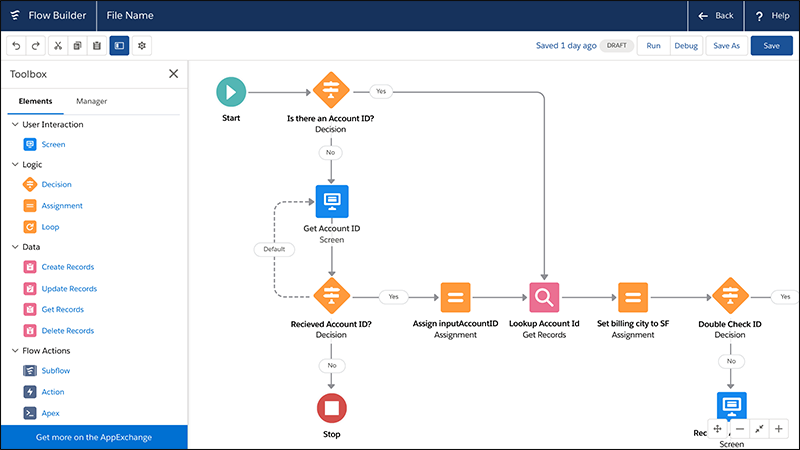Handy Tips To Selecting application development with Low-code platforms
Handy Tips To Selecting application development with Low-code platforms
Blog Article
Benefits Of Low-Code Application Development In Terms Of Integration Capabilities
Low-code development of applications offers huge advantages when it comes to integration capabilities, which are vital for developing applications that seamlessly connect with different systems and services. These are the main benefits: Pre-built Connectors and APIs:
Wide Selection of Connectors. Low-code software typically includes a wide range of pre-built connections to enterprise systems that are popular (e.g. cloud services, databases, CRM). The integration process is simplified.
API Integration: A lot of platforms have built-in API integration capabilities. This lets developers effortlessly connect with data from other sources and services.
Easy To Use
Drag-and-Drop Integration Tasks for integration can typically be accomplished using drag-and-drop interfaces, making it accessible to both developers and non-developers to set up complex integrations, without writing lots of code.
Visual Workflow builders: These visual tools are utilized to design workflows, data flow, and integrations. They aid in understanding and establishing them more efficiently.
Standardized Integration Methods:
SOAP/RESTful Service Support: Web services that use standard protocols, such as SOAP/REST, facilitate the integration of various different systems and applications.
OData and other Standards Support for other standards such as OData allows easy access and manipulation of data across different platforms and software.
Real-Time Data Synchronization:
Real-Time Integrations: Low-code platforms can handle the real-time synchronization of data between applications, systems and databases. This ensures that the data is always up-to date and consistent within an organization.
Event-Driven Architect: A few platforms are equipped with events-driven structures, allowing applications to respond immediately to events. This is important for dynamic interactive applications.
Legacy System Integration:
Low-code platforms are a great source of software to connect with existing systems. They allow organizations to modernize IT without having to overhaul their existing systems.
Data Migration Tools - Built in data-migration tools make it easy to transfer data from older systems to low-code applications.
Integration of Third-Party Services:
Cloud Services: Seamless Integration with Cloud Services such as AWS Azure Google Cloud and Google Cloud makes it easy to deploy applications.
Business Applications Integration: Low-code platforms can be integrated with different business applications like Salesforce, SAP and Microsoft Dynamics. This facilitates seamless flow between different business functions.
Simple Data Management:
Data models that are unifying: Certain platforms offer low-code support for unified data models to facilitate data management across platforms.
Data connectors: Data connectors that are preconfigured to provide easy access and manipulation to data from a variety of sources.
Security and compliance:
Secure Integrations: Low-code platforms guarantee that integrations adhere to security protocols and standard security standards, securing data in transit as well as at rest.
Compliance Features - These platforms come with features that make sure that the integrations are in compliance to regulatory standards.
Extensibility:
Custom Code and Scripts : Low-code platforms can often be able to handle more complicated integrations, allowing for the addition of custom scripts and codes. This allows for greater flexibility without sacrificing ease of usage.
Plug-in Ecosystem A collection of plugins and extensions will enhance integration capabilities through allowing users to easily create new features as needed.
In the end, the integration capabilities of low-code development platforms makes them an excellent instrument for developing efficient, interconnected, and scalable applications. They help connect various systems. They also improve data flow. Check out the top rated Low-code Platform for application development for website tips including software for app development, develop web app, app platforms, rad development, azure sql, low code platforms, rad development, app dev platform, push alerts, rapid application design and more.
Advantages Of Low-Code Application Development In Terms Of Governance And Security
Low-code applications offer a number of advantages when it comes to security and governance. These is essential to ensure that applications are compliant, secure, and well-managed throughout their lifespan. Here are some of the key advantages.
Unified management console Low code platforms typically provide a centralized administration console from which administrators can manage all applications and ensure consistent governance within the organization.
Role-Based Access Control: These platforms include robust role-based control that allows administrators to define policies and then enforce the rules. Only authorized users will be permitted to modify and access certain parts of the application.
Compliance and Regulatory Applicability:
Many low-code platforms come with built-in compliance functions. These are designed to ensure that applications comply with the industry standards (e.g. GDPR, HIPAA). They provide frameworks and tools that help to ensure applications meet these requirements.
Audit Trails & Logging: Complete audit trails and logs can be integrated to allow organizations to track change, monitor access and ensure the compliance.
Increased Security Measures
Data Encryption: Low-code platforms typically provide built-in encryption for data at rest and while in transit, making sure that sensitive information is protected.
Security Certifications – Many lowcode providers hold security certifications, such as ISO 27001 (or SOC2) which proves the compliance to high security standards. Customers can rest assured that the service adheres to these standards.
Automated updates to ensure security:
Regular patches and updates Low-code platforms can handle the majority of security patches and updates in a way. They make sure that applications are protected from the latest threats without having developers intervene manually.
Security Monitoring: Tools to conduct continuous monitoring of security are provided. They offer real-time alerts, as well as information about security concerns that could arise.
Data Governance
Data Access Policy: These platforms let companies define and enforce rules for data access, making sure that only authorized individuals are able to access data, and the data is utilized in a safe manner.
Data Masking, anonymization, and Anonymization Tools: These tools help secure sensitive personal information and are particularly useful in test environments.
Continuous application lifecycle management
Development and deployment pipelines: Low-code platforms provide integrated development and deployment, which includes security checks. This provides security throughout the entire lifecycle of the application.
Version Control: The integrated version control helps manage changes and ensures that any changes to the application can be identified and changed if necessary to ensure the integrity of the application.
User Authentication:
Single Sign-On - Support for single sign-on (SSO) and other advanced methods of authentication makes management easier and improves security.
Multi-Factor Authentication Most platforms come with built-in multi-factor authentication, providing a layer of extra security when accessing apps.
Policy Enforcement and Compliance:
Policy Templates: Low code platforms typically have templates for governance and security which allow companies to swiftly implement policies.
Tools for Monitoring Compliance: These tools are able to monitor and provide continuous reports on compliance status. They make it easier to spot issues and tackle them in a proactive manner.
Integration with Existing Security Infrastructure
Seamless Integration: Low-code platforms are designed to integrate seamlessly with existing security infrastructure and tools, such as identity management tools and SIEMs (Security Information and Event Management Solutions), and firewalls.
API Security API Security: Built-in API security features make sure that integrations with external systems are secure, protecting data and maintaining application integrity.
Training and best practices:
A lot of platforms provide guidelines and best practice for secure application development. They assist non-developers to adhere to security standards.
Security Training Some low code companies offer security resources and training to users to teach them how to create and maintain secure applications.
Overall the security and governance benefits of low-code development assure that the applications are developed and maintained in a safe, compliant, and controlled way. These platforms provide the tools and frameworks necessary to secure sensitive data as well as enforce policies and maintain regulatory compliance, all while simplifying management and oversight of the application development process. See the top rated Legacy application modernization with Low-code blog for blog info including software for app development, driver jdbc, azure sql, develop web app, driver jdbc, sso azure, paas service, cross platform app dev, rad development, database in azure and more.
The Benefits Of Low-Code Development For The Development Of Applications In Terms Of The Limitations And The Possibility Of Customization
Low-code app development is a well-balanced solution that has significant advantages in addressing limitations while allowing customization. Here are the benefits:
Overcoming Complexity Barriers
Low-code platforms make development easier by providing pre-built templates and other components. This facilitates quicker deployment and the development of more complex applications.
Guided Workflows - A lot of platforms have wizards or workflows that help developers navigate difficult procedures. This reduces the risk of error and ensures accuracy.
Scalability Solutions
Scalability is built in: Low-code platform often includes features that enable scalable architecture. Applications can handle increased workloads with minimal development.
Performance Monitoring Performance Monitoring Tools: Integrated performance monitoring tools and optimization ensure applications are as efficient as they can be, no matter their scale.
Security and compliance
Integrated security features: Low-code platforms have security measures like encryption and access control based on role, and automated compliance checking that address security issues.
Platforms are continuously changing their security procedures as well as measures of conformity, which assures that applications remain safe against emerging threats.
Customization capabilities:
Extensibility:
Low-code platforms allow developers to enhance functionality beyond the standard offerings by integrating custom code.
Custom Plugins and Modules Developers can design customized plugins or modules that include specific functions that are tailored to the specific requirements of a particular business.
APIs and integration:
API Support: Comprehensive API support permits seamless integration of services and systems from outside. This facilitates extensive customization and connectivity.
Third Party Services: Low-code platforms often provide pre-built connectors for well-known third-party services, making it easier to customize and integrate applications.
Flexible UI/UX Design:
Customizable interfaces: Users can customize and design their own user interfaces, that will give users with a customized experience.
Responsive Design The built-in capabilities of responsive design ensure that applications are able to be customized for different screens and devices.
Business Logic Customization
Visual Workflow Builders: Visual tools that allow you to design and customize workflows, business logic and processes allow developers to design intricate and custom processes with no extensive programming.
Platforms can be equipped with conditional Logic which permits the development of custom scripts designed to deal with certain scenarios or business rules.
Data Management
Custom Data Models: Developers are able to create custom data models to satisfy specific requirements of an application, and ensure that data handling meets the requirements of business.
Advanced Data Processor: The combination of advanced data processing tools and capabilities allows the customisation of the method by which data is analysed and used within the application.
Customisation and balancing limits:
Frameworks and Standards
Best Practices: A low-code platform encourages adherence to standards and best practices in the industry. This helps to ensure high-quality secure, scalable, and scalable applications.
Governance Frameworks: Integrated governance frameworks ensure that the customizations do not affect the integrity, conformity, or the security of an application.
Iterative Development:
Rapid prototyping: Being capable of rapidly prototyping and test their modifications, developers are able to iterate on the feedback of users to enhance the app.
Continuous Improvement: Low code platforms enable constant improvements. They can be modified and customized to meet the changing needs of business.
User Empowerment:
Low-code platforms empower citizen developers: By allowing non-developers, through intuitive interfaces to customize applications, they expand the pool of developers who can modify and enhance apps.
Support and Training: A lot of platforms have extensive resources for training and support that can assist users with making efficient customizations without compromising stability or performance.
Overall, Low-code application creation offers a framework that is robust and adaptable enough to meet constraints while also allowing the possibility of extensive customisation. This allows businesses to create and maintain applications that are efficient, adapted for their specific needs and that meet high standards of quality, security and scaling.